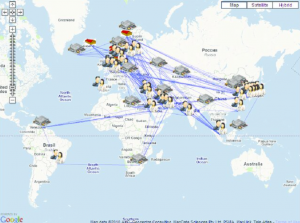In 2008 Satoshi Nakamoto[1] published a paper[2] on the cryptography mailing list metzdowd.com[3] describing a method for preventing double-spend of digital currencies using digital signatures, peer-to-peer networks and a concept called ‘proof-of-work’. His idea resulted in the first cryptocurrency Bitcoin, market capitalisation at time of writing $4.2 Billion USD[4].
The success of Bitcoin generated a slew of imitators and interest in the technology is now extending beyond the field of cryptocurrencies. The distributed public ledger concept central to Bitcoin has become known as The Blockchain and is being been touted as a potential replacement for any existing centralised database. Just as Bitcoin is now seen by some as a viable alternative to banks some see The Blockchain as a potential alternative to other centrally administered civic institutions, such as, in the field of land administration, land registries.
Although not mainstream this idea is slowly gaining traction in land administration circles. In May 2015 the Young Surveyors Network of the International Federation of Surveyors (FIG) Working Week ran a workshop entitled ‘Surveying the Future: Mapping the Bitcoins’, the presentation was prepared by Paula Dijkstra, Christiaan Lemmen, Annet de Boer from the cadastral agency in the Netherlands and by Eva-Maria Unger, chair of the Young Surveyors Network (from the Austrain cadastre).[5].’ Around the same time Reuters reported that Honduras is piloting a land registry using Bitcoin technology[6], while in northern Ghana an organisation called Bitland has begun implementing a land registry and titling protocol using the Bitcoin’s Blockchain to timestamp land titles[7].
To understand how Blockchain technology might be applied to land administration a good starting point is to examine some of the principles that underlie the initial application Bitcoin.
How does Bitcoin work?
Bitcoin is traded over and administered by a distributed network of nodes connected via the internet. Anyone wishing to buy or sell Bitcoin must first become a node on this distributed network. This is done by downloading a peer-to-peer networking application known in Bitcoin parlance as a Wallet. It is also possible to sign up for an online third party Wallet service.
The Wallet software generates private and public keys used to digitally sign your transactions. It is common practice in Bitcoin to generate a new private and public key for every transaction to maximise privacy, but in a fully transparent system your public key could also act as your unique identifier.
The Wallet software initially downloads, and then continually syncs with, The Blockchain. At the time of writing approximately 20GB of data. This is the definitive record of every transaction in the history of the Bitcoin cryptocurrency.
To make a Bitcoin transaction a user must broadcast the details of the transaction to the network using their Wallet application. The transaction is signed digitally and contains the unique key of both parties. Specialist nodes called “miners” collect hundreds of transactions together into a bundle called a “block”. Miners validate the transactions (check The Blockchain to check it has not been already spent – described as a double spend) and then complete a ‘proof of work’; a computationally difficult, but easily verifiable, calculation. The first miner to complete the proof of work (as verified by the other nodes) adds their block of transactions to The Blockchain and receives a reward, currently 25 bitcoin (£3,880.51 at time of writing), plus any additional transaction fees.
The Blockchain is not technically immutable, but it is computationally impractical for an attacker to alter it, provided honest nodes control a majority of CPU power in the network. Currently the distributed computational power in the Bitcoin network is thought to be 280 times more powerful than the top five supercomputers in the world[8].
In addition to being difficult to corrupt, the incentives provided to Bitcoin miners mean that it is more financially advantageous for actors with access to large amounts of computing power to use it to mine Bitcoin, thereby administering the system, than attempt to corrupt The Blockchain.
How could Blockchain technology be applied to land administration
Factom, the company appointed by the government of Honduras to apply Bitcoin technology to its land registry has developed a technology that inserts references to data stored within its own peer-to-peer network into the Bitcoin Blockchain thereby piggy backing on Bitcoin’s trust and immutability. The references are inserted using Bitcoin’s OP_RETURN protocol, introduced in 2013, that allows users to insert up to 40 bytes of data into any transaction. It seems likely (from a reading of Factom’s whitepaper[9]) that the system will be a method of recording deed transaction and will only provide a record that the transaction has occurred. The system will not attempt to validate the transaction. This is analogous to a registry of deeds, or title registry.
Bitland’s method is similar, but is more open and uses a suite of already available technologies. GPS, or aerial imagery is used to delineate plots which are added to the cadastral layer in Open Street Map. Title deeds are drawn up using the standard land title contract including references to the mapping. The land titles are signed using the land owner’s Public Key and the Public Keys of neighbouring landowners to indicate consensus. The existence of the title deeds is then time stamped and immortalised by inserting it into the Bitcoin Blockchain using a service such as btproof[10] or proofofexistence[11]. This services allows you to create a cryptographic hash unique to your document and to insert it into a Bitcoin transaction. When this transaction is inserted into the Blockchain, the block it is within is timestamped. The hash stored in The Blockchain alongside an original copy of the title deed is proof that the title deed existed at a point in time, the Blockchain acts as a public notary.
Inserting references to title deeds into The Blockchain proves that the deed existed, but not that it was valid. A system that could also validate a transaction would have to include a method of linking ownership of land, or a land right, to a cryptocoin so that when the coin is transferred the right is transferred with it. The FIG Working Week suggested linking land units with Bitcoins on a one coin per unit, or part of one coin per unit basis see Fig 1. Bitland also suggests a similar approach using the Bitcoin Meta Protocol Colored Coins.
Figure 1: Images from Surveying the Future: Mapping the Bitcoin. FIG Working Week 2015. The Grid represents units of land linked to Bitcoins, or partial Bitcoins.
An alternative to linking transactions to Bitcoin would be to set up an entirely new protocol based on Bitcoin/Blockchain technology, but for the express purpose of recording land transactions. The advantage of this method is that each coin could be specifically linked to a geographic entity such as a grid square, a link that could be hard coded into the coin’s ID. The validation mechanism built into the system would ensure that it would be impossible for two entities to hold the rights to the same piece of land simultaneously. You could feasibly also programme the protocol to include a mechanism for validating real world identity. The problem is that the system would require a mechanism to incentivise the miners needed to validate the transactions and maintain The Blockchain ledger. Because land is finite it is not possible to grant land as an incentive to the miners. The system would have to rely on transaction fees, which would have to be maintained at a sufficiently high level to attract enough miners to ensure the integrity of your new Blockchain.
Another advantage of setting up an entirely new protocol is that control over how the protocol develops over time can be secured. Bitcoin is an open source project, currently there are five developers with push access to the Github project for the Bitcoin core protocol. In August 2015 a dispute among this group over the correct size for a block led to the development of a rival protocol[12]. Making a protocol critical to a country’s land transactions and then ceding control of that protocol is risky because changes to the protocol could disrupt the land administration process. For example the timestamping services used by Bitland to insert hashes into The Blockchain alters the public keys used in the transaction in a way that prevents the Bitcoin in that transaction ever being spent again. Some within the Bitcoin community consider this a corruption of The Blockchain and want the protocol changed to prevent it. Similarly the OP_RETURN protocol used by Factcom was reduced to 40 bytes from 80 bytes by the core developers, the developers retain the power to reduce it further or remove it altogether[13].
The advantages of Blockchain for land administration
Existing land information systems are typically centralised ledgers containing records of a nation’s land transactions. Where they function well they underpin the value of the country’s land assets by guaranteeing title, or facilitating a system of title insurance. Where they are dysfunctional they inhibit economic growth by reducing security of tenure, provoking ownership disputes and concealing corruption. A Blockchain land registry would have the same function (and potential problems and benefits) as a traditional land registry, but with one key difference, the ledger (the record of the nation’s land transactions) would be decentralised. Theoretically this could have a number of advantages over a centralised system.
Resilience: every node on the network would have a full copy of the ledger. This level of redundancy would make the registry almost indestructible. Flood, fire, electrical storm, invading army; The Blockchain persists.
Trust: land registries trade on trust. As described above, the Bitcoin Blockchain, as it is currently operates, is effectively immutable. Most centralised land registries also cannot be altered without due process and a fully documented audit trail, but there have been cases of countries with weak institutions where corrupt and powerful interests have used influence to disrupt due process.
Transparency: every transaction is in the open for anyone to see. Every node on the network has all the information they need for an audit of every transaction. However for full auditability there would need to be a mechanism for identifying the parties involved in the transactions, currently this is not possible with Bitcoin.
Efficiency: by removing third parties you can theoretically increase the efficiency of the system. The land registry in England and Wales had an operating cost of £239.9 million in 2013/14[14], this is only part of the total cost to the economy of land transactions, with a full picture including the fees charged by solicitors.
Automation: property transactions often rely on chains, a buyer needs to sell their property before they can buy and so on. It would be possible to automate such chains with a transaction being programmed to proceed once a defined transaction appears as complete in The Blockchain.
Questions remain
Many of the benefits listed above are also benefits of any digital land registry, not exclusive to The Blockchain. Any fully digital e-conveyancing system could be set up to eliminate or minimise expensive third parties and could even be programmed to carry out automated chains of transactions. The UK Land Registry experimented with exactly this type of system over five years ago but shelved it citing a lack of interest[15]. The fact that so few fully digital land registries exist is not due to a lack of technology, but more to do with a lack of political will and resistance from vested interests.
There are also many examples of digital land registries failing to deliver promised improvements in land administration processes. Rarely is it the technology that is ultimately at fault, more often it is tricky real world issues, such as correctly identifying the initial rights holder and documenting the geographic boundary of a claim. These issues would be equally difficult to handle regardless of the particular land registry’s underlying technology.
The benefit of transparency provided by The Blockchain is also already available to a centralised land registry if its data is made open and freely available. Although The Blockchain concept has built in transparency it can still be used in an anonymous way by generating a new unique key for every transaction. For any system of land registration using Blockchain technology to work there would need to be a mechanism for linking the transactions recorded in The Blockchain with real world identities. If this identity database is centralised you are effectively replacing a single centralised database with a decentralised database plus an adjunct centralised database.
The Blockchain used for Bitcoin is very resilient and secure, but the resilience and security of the network depends on its users (the integrity of The Blockchain relies on it being computationally impractical for an attacker to alter provided honest nodes control a majority of CPU power in the network). The website Bitnodes recorded the number of reachable nodes in the Bitcoin network as 6139 at the time of writing[16]. This offers a huge amount of redundancy (copies of The Blockchain), plus a huge amount of distributed computational power. But will the network always be this healthy? What if the value of the currency collapses below a level where it is uneconomical for miners to participate? If a country had linked its land registry to Bitcoin would the government have to step in and provide its own nodes? In addition should a nation rely on a distributed network of unknown actors for the integrity of its land registry? Would this not expose them to the risk of cyber attack from malicious foreign powers?
Ultimately it may come down to a question of trust, or more accurately (since proponents of Bitcoin describe The Blockchain as a trust-less system) reputation. The value of a land administration system lies not in its efficiency, so long as it functions adequately. The value is in the level of trust that is placed in it based on its reputation. Property systems in the UK are considered so trustworthy that billions of pounds a year flow into them from hundreds of other countries where assets are not considered to be as secure. Will a technology that is currently synonymous with drug dealers provide the same level as assurance and trust as such respected and esteemed institutions as the Land Registry, the Law Society and the Royal Institution of Chartered Surveyors, who, for a healthy, but reasonable fee, currently administer the system of land transactions in the UK? If the answer is “no” then the cost to the UK economy of instituting a Blockchain land registry would be considerably greater than any efficiency savings such a system could offer.
Published 19th August 2015 by Philip Knight, Senior Consultant, ConsultingWhere
Correction: a previous version of this article omitted to mention that ‘Surveying the Future: Mapping the Bitcoins’ was a workshop organised by the Young Surveyors Network outside of the main programme of the FIG Working Week.
[1] Satoshi Nakamoto is almost certainly a pseudonym, despite numerous attempts to identify him the real identity of Satoshi Nakamoto remains a mystery.
[2] Bitcoin: A Peer-to-Peer Electronic Cash System https://bitcoin.org/bitcoin.pdf
[3] Archive of Satoshi Nakamoto’s posts at metzdowd.com http://www.mail-archive.com/search?l=cryptography@metzdowd.com&q=from:%22Satoshi+Nakamoto%22
[4] Market capitalisation as of 29th July 2015: https://blockchain.info/charts/market-cap
[5] P Dijkstra, C Lemmen, A De-Boer (Kadaster) E M Unger (BEV). FIG Working Week, Young Surveyors Session. ‘Surveying the Future: Mapping the Bitcoins’, available at: http://www.fig.net/resources/proceedings/fig_proceedings/fig2015/ppt/ys/ys_bitcoins.pdf
[6] Reuters, ‘Honduras to build land title registry using bitcoin technology’, available at: http://in.reuters.com/article/2015/05/15/usa-honduras-technology-idINKBN0O01V720150515
[7] Bitland Homepage, available at: http://bitland.adsactly.com/blog/bitland-overview/
[8] Wired Retail, ‘Bitcoin might fail but the blockchain is here to stay’, available at: https://www.youtube.com/watch?v=jbu6I-8mNUo&t=8m24s
[9] Factom, Whitepaper, available at: https://github.com/FactomProject/FactomDocs/blob/master/Factom_Whitepaper.pdf?raw=true
[10] BTProof, homepage, available at: https://www.btproof.com/
[11] Proofofexistence, homepage, available at: http://www.proofofexistence.com/
[12] The Guardian: ‘Bitcoin’s forked: chief scientist launches alternative proposal for the currency’, available at: http://www.theguardian.com/technology/2015/aug/17/bitcoin-xt-alternative-cryptocurrency-chief-scientist
[13] Coindesk: ‘Developers Battle Over Bitcoin Block Chain’, available at: http://www.coindesk.com/developers-battle-bitcoin-block-chain/
[14] HM Land Registry, ‘Annual Report and Accounts 2013/14’,
available at: https://www.gov.uk/government/uploads/system/uploads/at
tachment_data/file/332490/Land_Registry_Annual_Report2014v27Aweb.pdf
[15] The Guardian, ‘Web plan for property sales shelved after lack of interest in pilot’, available at: http://www.theguardian.com/technology/2008/apr/10/property
[16] Reachable nodes as of Fri Jul 31 2015 17:13:42, sourced via: https://getaddr.bitnodes.io/




